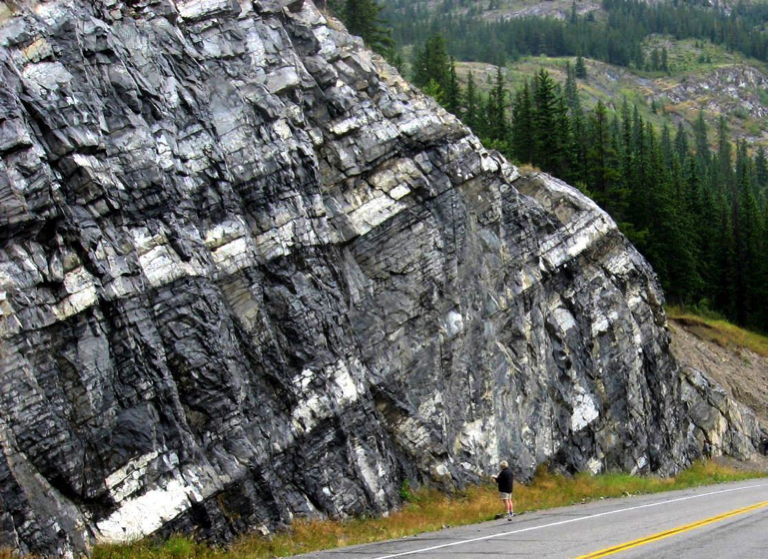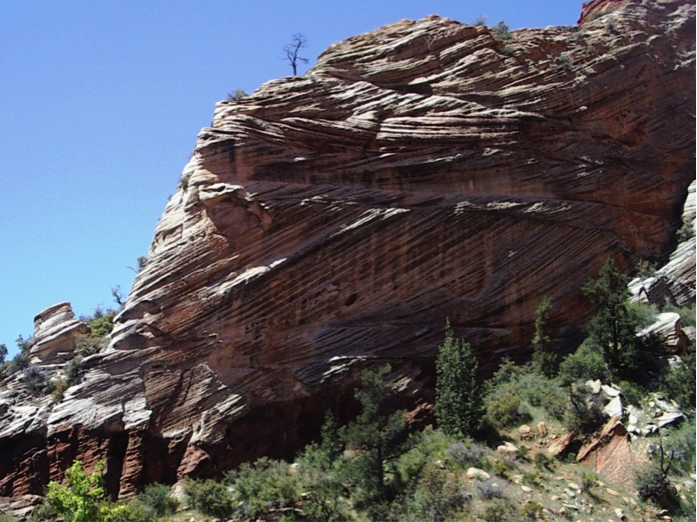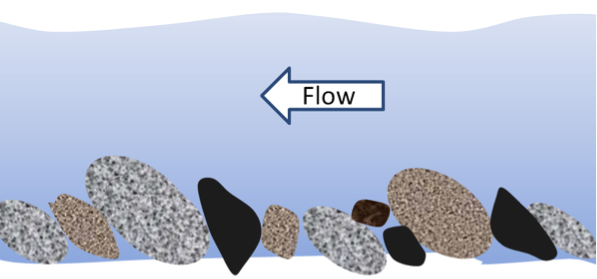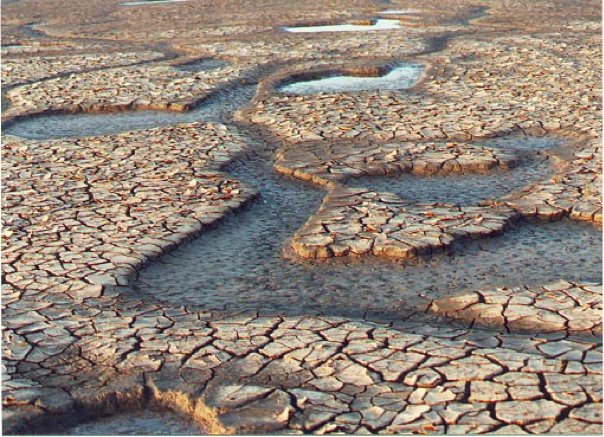9.5 Sedimentary Structures and Fossils
So far you’ve learned that the characteristics of sedimentary rocks will depend on the environment in which they formed, because those environments determine what kinds of particles are available to make rocks, what ions are present, and how particles or ions move and accumulate. Geologists look very closely at sedimentary grains to determine their mineralogy or lithology (in order to make inferences about the type of source rock and the weathering processes), their degree of rounding, their sizes, and the extent to which they have been sorted by transportation and depositional processes.
But depositional environments also put their unique footprint on sedimentary rocks by causing rocks to develop different sedimentary structures as they form. By understanding the origins of those structures, we can make some very useful inferences about the processes and depositional environment that ultimately resulted in the rocks that we are studying.
Types of Layering
Bedding refers to sedimentary layers that can be distinguished from one another on the basis of characteristics such as texture, composition, colour, or weathering characteristics (Figure 9.21). They may also be similar layers separated by partings, narrow regions marking weaker surfaces where erosion is enhanced. Bedding is an indication of changes in depositional processes that may be related to seasonal differences, changes in climate, changes in locations of rivers or deltas, or tectonic changes. Bedding can form in almost any depositional environment.

Cross-bedding is bedding that contains angled layers. It forms when sediments are deposited by flowing water or wind (Figure 9.22). Cross-beds in streams tend to be on the scale of cm to tens of cm, while those in aeolian (wind deposited) sediments can be on the scale of metres.

Cross-beds form as sediments are deposited on the leading edge of an advancing ripple or dune. Each layer is related to a different ripple that advances in the flow direction, and is partially eroded by the following ripple (Figure 9.23). Cross-bedding is a very important sedimentary structure to recognize because it can provide information on the direction of current flows and, when analyzed in detail, on other features like the rate of flow and the amount of sediment available.

Ripples, generated by flowing water may be preserved on the surfaces of sedimentary beds. Ripples associated with the formation of cross-bedding under unidirectional flow can help to determine flow direction because they tend to have their steepest surface facing down-flow. Ripples can also form from back-and-forth sloshing flows. These are symmetrical, and are a sure sign of a beach.
Imbrication is another sign of flowing water. In a stream environment, boulders, cobbles, and pebbles can become tilted in the same general direction. Clasts in streams tend to tilt with their upper ends pointing downstream, because this is the most stable position with respect to the stream flow (Figure 9.24).

Graded bedding is characterized by a change in grain size from bottom to top within a single bed. “Normal” graded beds are coarse at the bottom and become finer toward the top (Figure 9.25), a product of deposition from a slowing current. Some graded beds are reversed (coarser at the top), and this normally results from deposition by a fast-moving debris flow. Most graded beds form in a submarine fan environment, where sediment-rich flows called turbidites descend periodically from a shallow marine shelf down a slope and onto the deeper sea floor.

Other Structures
Mud cracks form when a shallow body of water (e.g., a tidal flat or pond), into which muddy sediments have been deposited, dries up and cracks (Figure 9.26). This happens because the clay in the upper mud layers shrinks upon drying.

A Note About Fossils
Fossils are not covered in detail in this book, but they are extremely important for understanding sedimentary rocks. Fossils can be used to date sedimentary rocks, but just as importantly, they tell us a great deal about the depositional environment of the sediments and the climate at the time. They can help to differentiate marine, aquatic, and terrestrial environments; estimate the depth of the water; detect the existence of currents; and even to estimate average temperature and precipitation.
Practice with Sedimentary Structures
Can you name these structures? Turn the card to check your answer.
Putting It All Together: Murder Mystery Challenge
Can you combine what you’ve learned so far about the rock cycle, weathering, sediments, sedimentary rocks, and sedimentary structures to solve these cases?
For each case you are given the evidence (details about a sedimentary rock). It’s your job to figure out who the victim was (the source rock), the murder weapon (what kind of weathering transformed the source rock), the get-away car (how the sediment was transported), and the crime scene (where the sediment was deposited and lithified). If you get stuck, click on the tips for additional clues.

